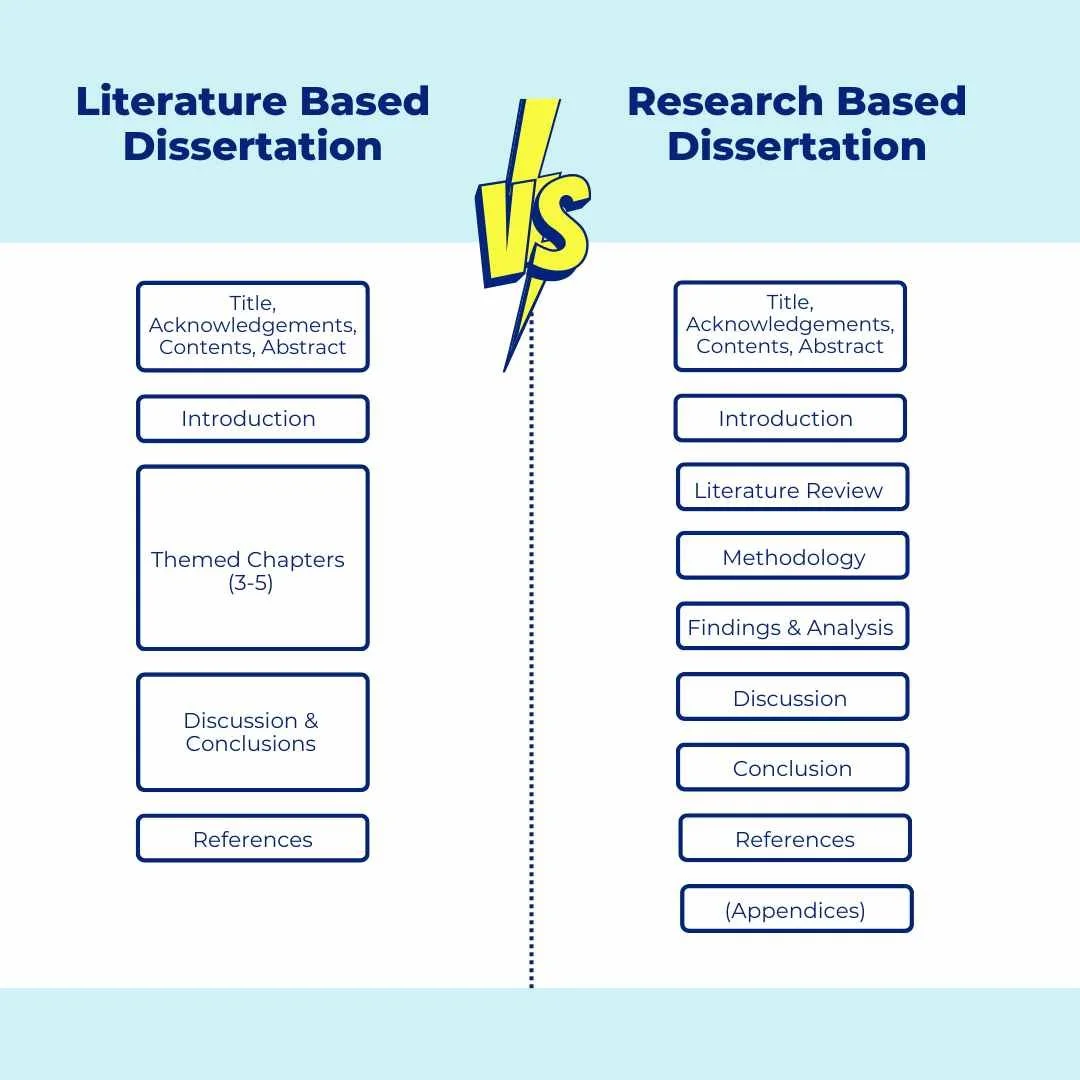The three different types of social science dissertation
The details and advantages & disadvantages of primary research, secondary research and literature-based dissertations
Primary research, secondary research.
Literature based dissertation.
Desk based dissertation.
Wait a minute. Isn’t a desk based-dissertation the same as secondary research? Isn’t a literature based dissertation actually a secondary research project?
Confusing, isn’t it?
But don’t worry, keep reading because in this blogpost I’m going to explain the three main types of social science dissertation - primary research, secondary research and literature-based, and some of the pros and cons of each. By the end of this blogpost. you will know what these three types are, and you’ll be thinking about which one you might consider for your own dissertation.
Primary research dissertation
This type of dissertation is when you collect your own data and analyse your own data.
You are the primary collector of the data. You are the primary analyst of that data.
For example, you might be interested in young people’s experiences of using social media to find graduate employment. You could develop an online questionnaire and invite people to complete that. When you’ve got all your completed questionnaires, you then do your own analysis of your data using whatever technique is your jam – descriptive statistics, analytical statistics, qualitative thematic analysis etc. Alternatively, you might go into an online forum where young people are discussing their experiences of finding graduate employment and – with permission – you might collect data from that forum by taking a sample of the posts in there, then you could analyse that data by doing a content analysis of the posts.
The two key things to remember about primary research dissertations are: you collect your own data, and you analyse your own data.
Advantages
You are 100% in control of what you collect and analyse data on. You set the questions; you decide how you’re going to analyse it.
It can be a good warm up for further study like a PhD or for working in a profession where you need to do research style projects to find out what your clients or customers want or need or what they thought about your product or service.
By doing a primary research dissertation yourself, you get valuable insights into the research process, which you won’t get from just reading about it. You roll up your sleeves, you get your hands dirty, you get to experience how research works on the ground.
Disadvantages
You are dependent upon other people doing things – responding to your questionnaire, turning up for an interview, giving permission to research in their online space, negotiating access to participants. Sometimes, people don’t always do what they say they’re going to do. You’ll need to have a plan b, and a plan c and get used to having to use those contingency plans.
You need to stick to a fairly rigid timetable – you will need to get ethical approval by a particular date, collect your data by a particular date so it does bring with it specific time pressures. You might wake up in a sweat at 0300 because only 4 people have completed your survey. You are liable to have nightmares about your questionnaire chasing you down the street. That actually happened to a lovely lady I knew when I was doing my PhD. She’s fine now. But that was a dark time for her.
Secondary research dissertation
In a secondary research dissertation, you do not collect your own data.
Instead, you use data that has been collected by another researcher.
You take that data and do your own analysis of it.
Someone else has collected the data, but you do the analysis of it.
For example, you might be interested in exploring differences in beliefs and values around diversity in different European countries. You might go and check out the European Social Survey and download some data to use for your own research. You might put the data into a statistical analysis package like IBM’s SPSS (Statistical Package for Social Sciences).
Advantages
You don’t have to collect your own data. Yay! That saves you time and effort.
If you use a large scale, established data set like the European Social Survey, the Understanding Society Survey, the Millennium Cohort Study or the Labour Force Survey, you can be assured that these datasets are valid and reliable.
You can potentially shed new light on that data by asking different questions of it or looking at it in a different way. You are helping to ensure that data someone else has collected is maximised in terms of social value.
You have a bit more flexibility in terms of your research timetable than in a primary research dissertation because the milestones and deadlines around data collection don’t really exist, especially if you’re accessing publicly available datasets and you don’t have to request access to them.
Disadvantages
You haven’t collected the data, so you have to just work with what you’ve got.
You are limited in your choice of dissertation topic.
You may find yourself having to shift your research questions around a little to fit the data that’s available to you, so you don’t get to do the exact dissertation you wanted to, you end up looking at something slightly different from what you’d planned.
You don’t get the hand-on experience of collecting the data yourself, which can be a great opportunity to develop your data collection skills.
Literature based dissertation
In a literature-based dissertation, your entire dissertation is a literature review. It’s a big, bad, pumped, supercharged literature review!
You take your research question and do a thorough, critical, strategic review of the literature around that question.
Your original contribution to knowledge – or where you fill the gap – is the new insights you generate from your critical synthesis of the existing literature.
Think of a literature based dissertation like making a lovely piece of crochet. You draw upon different strands and threads of the existing literature, some of which might never have been connected before. You crochet them all together to create new, innovative insights into your topic.
It’s likely that no one has ever approached the literature with your questions before, seeking answers to the specific things that you’re looking at, so you will produce a unique contribution to knowledge in your dissertation.
There are a couple of things about the structure of literature based dissertations that differ from primary and secondary research dissertations. Look at the graphic below.
Literature based dissertations don't have a chapter called the Literature Review, because the entire thing is a literature review. It doesn’t make any sense to have a Literature Review chapter!
Instead, you have a series of themed chapters - usually between three and five - each critically examining a specific area of the literature. You draw them all together to answer your research question to provide those new insights into your topic.
For example, you might want to do a dissertation about The development of feminist thought in the early twenty first century. Your themed chapters might look like this.
Feminist thought, a description and analysis: Exploring what ‘feminist thought’ actually is and where it comes from.
Twenty-first century challenges for feminism: Examining the context of the twenty-first century and specific challenges that the feminist movement is concerned with addressing.
The current state of feminist thought in 2023: Identifying and evaluating the landscape of feminist thought right now, what does it look like?
Rhetoric and reality - feminist thought in practice: Exploring the ways in which feminist thought has influenced particular policies or practices.
The future is feminist? Considering the future of feminist thought and where it’s headed from here.
The other thing you need to bear in mind about the structure of a literature based dissertation is that they don't have a separate Methodology chapter. Instead, Your Introduction chapter will include a section in which you provide an overview of your approach to your dissertation, explaining your strategy for finding and critically reviewing the literature.
Advantages
You avoid the logistical issues associated with primary research based dissertations – you aren’t dealing with people, you’re dealing with literature, and the only person you need to rely on is yourself- and maybe your friendly librarian who will help you out with things like inter-library loans!
It opens up a wider range of topics for you than primary or secondary research based dissertations do. This is great if you want to look at a topic you would never get ethical approval to do a primary study on.
It provides you with much more time flexibility than a primary or secondary research based dissertation. Those deadlines around ethical approval, accessing data, analysing data don’t apply to you.
Disadvantages
Some disciplines tend to think that they’re not as ‘good’ as a research based dissertation, because the capacity to do an independent research project is a big part of your professional identity in that discipline.
In my view, literature based dissertations are probably the hardest type of dissertation to do – because weaving together strands of the literature to provide an answer to your question can get super complex. Like I said earlier, this is likely to first time anyone has approached the literature asking the questions that you’re asking – and you’ve got to figure out what the answers are and how they all fit together.
“Desk-based” dissertations
Lastly, I want to say a few words about the term “desk based dissertation”.
The term “desk based dissertation” used to be another name for the literature-based dissertation.
This was because you did it from your desk or a desk in the library. That distinguished it from primary and secondary research based studies, because you had to physically get up from your desk to do that kind of research. You had to interview your participants. In person. Face to face. You had to go drop your questionnaires off at various locations for people to pick up and complete. You had to display posters about your research on noticeboards. If you were doing secondary research, you had to go to the place that held the actual datasets. That might have been another university in a town or city many miles away.
However, due to the wonders of technology, you can do primary and secondary research dissertations at your desk now if you so wish. Interviews can be done via zoom, questionnaires shared through Facebook. You can go online and access a wealth of large datasets for secondary analysis.
Every type of dissertation can be a desk-based dissertation now, as long as that desk has a computer on it that’s connected to the internet. Accordingly, the term “desk-based” dissertation has become pretty useless!
Next steps
I hope you’ve found this blogpost helpful and you’re a bit clearer now on what the three different types of dissertations are, and which one you’re leaning towards.
If you would like more dissertation advice and tips, become a degree Doctor insider and sign up for my email list by clicking on the button below!






